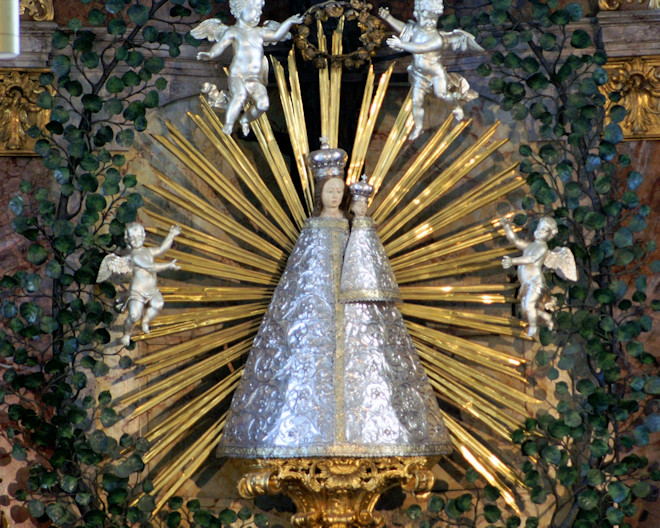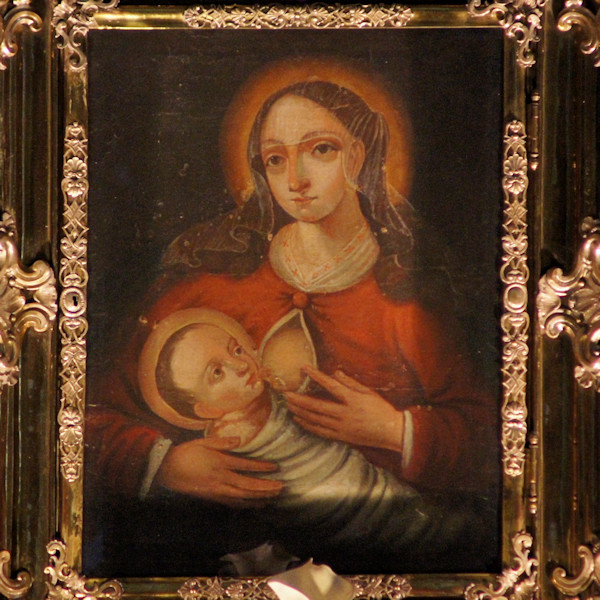The Way of St. James in Vienna begins at St. Stephen's Square in front of the Giant Gate.

In his guide, Peter Lindenthal recommends either bypassing Vienna on a large scale or crossing it by public transport. I would like to advise against the route through Hadikgasse recommended in the Outdoor and Cosmos Pilgrim Guide, if only because of the car exhaust fumes and noise. There is a wonderful path, which I would like to describe here in detail. It would be a pity not to walk it.
The path was signposted in 2018 almost exactly as I have described it here. The deviations are:
-
Around the Auer Welsbach Park on asphalt along the road instead of diagonally through the park on gravel.
-
Not through the beautiful Schönbrunn Palace Park, but on asphalt along the outside of the wall.
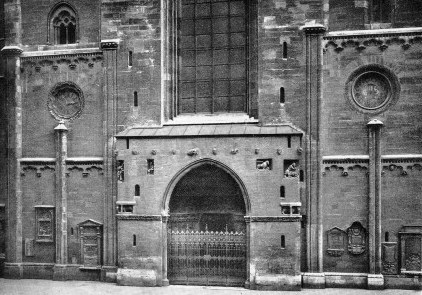
The Giant Gate, photo from 1926, meaning before the devastating destruction of the Second World War.
If you want to know what it looked like there in 2011 - after the restoration of the west façade, click on the year.
Like I said, we'll start at the giant gate. But wait! The moment of leaving, of saying goodbye and letting go is far too important for us - more important than the arrival - just to simply march off in a rash. Let us first go to the cathedral and ask God for his blessing for our project.
Special pictures of the interior of the cathedral
A look at the "first floor" of St. Stephen's Church shows us the many saints standing at the columns. They will accompany us. Again and again we will meet one or the other on the way and we will get to know many new saints. But let us concentrate on Mary, the Mother of God, who is present in the cathedral in many ways.
It will be seen: the Austrian Way of St. James is also a Marian pilgrimage route. Let us begin with the picture "Maria Pócs" in St. Stephen's Cathedral. We will hike from one Marian pilgrimage site to another until we reach the statue of the Virgin Mary in the Liebfrauenkirche in Rankweil. We will be accompanied by the "Mariahilfbild", which we will encounter again and again. The "Mariahilfbild" of the Vienna Mariahilferkirche was kept here in St. Stephen's Cathedral during the second Turkish siege.
The cathedral is dedicated to St. Stephen and all saints. But because of the 93 depictions of Mary counted, it is actually also a St. Mary's Cathedral.

The image of Maria Pócs, which originally came from Hungary, is particularly revered. From early morning to late in the evening prayers are offered before the "Pócs mother". The picture is said to have shed tears.
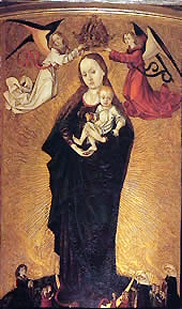
On the left side in the cathedral, at the second altar after the pulpit, the so-called "Old Women's Altar", there is the Gothic representation of "Mary in the Sun". We will meet her again in Ybbs on the Danube.
The miraculous image was originally in the Augustinian church. Two angels hold the Habsburg house crown over Mary.
More on the subject: Mary in the sun
By the way: The apostle James (on the right side of the picture) has his place in the middle section of the right, southern aisle, which in its continuation is called apostle choir.
If St. Stephen's Church is too much in the hands of tourists, we find peace in the Eligius Chapel, right next to the altar for Maria Pócs, where Wolfgang Amadeus Mozart is said to have married his Constanze. There is the Gothic statue of Our Lady of the Himmelpfort monastery (about which there is a beautiful legend) and Swiss pilgrims find St. Leodegar (patron saint of Lucerne) on the left altar leaf of the small Gothic altar.
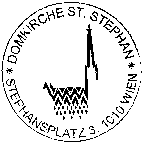
The pilgrim stamp is available in the cathedral shop

Let's go, first across the "Graben", past the fountain with St. Leopold, the patron saint of the country, the baroque (extensively renovated) plague column and the Joseph fountain.

At the end of the Graben we turn left into Kohlmarkt. There at the corner we find a signpost of the Jakobsweg. We walk to Michaelerplatz and cross the Hofburg.
We are already at the Heldenplatz with the equestrian statues of Prince Eugene and Archduke Karl. We go through the castle gate and cross the ring.
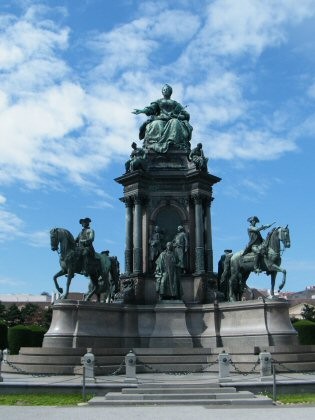
Our route leads between the two museums, past the monument to Empress Maria Theresa, who is surrounded here by her four great generals: Daun, Laudon, Traun and Khevenhüller.
At the pedestrian crossing over the car lanes at Museumsplatz we reach the square in front of the exhibition building, the former court stables and turn left into Mariahilferstrasse.
At the beginning of the Mariahilferstrasse, stands this little-noticed Nepomuk. The ford it once protected has long since ceased to exist. Here a view back, to the museums, from where we came.
When studying old maps of Vienna, it becomes clear that the Mariahilferstrasse was the way to the west and not the Wiental. There one could not walk at all before the Vienna regulation and covering.
Reports of Marian pilgrimages in the 17th and 18th centuries also attest to the Mariahilferstrasse and Linzerstrasse as a pilgrimage route to the west.
We walk up the Mariahilferstrasse. Some years ago trees were planted here, which are already quite big now. Since 2013 the Mariahilferstrasse is partly pedestrian zone with bicycle traffic. Soon we see the Collegiate Church on the right and when we finally reach the top of the hill, we find our first Marian pilgrimage church on the left, the Mariahilf Church, which gave the street and the whole district its name.
By the way, the left of the two statues of saints on the front of the Mariahilferkirche is St. Bartolomäus.
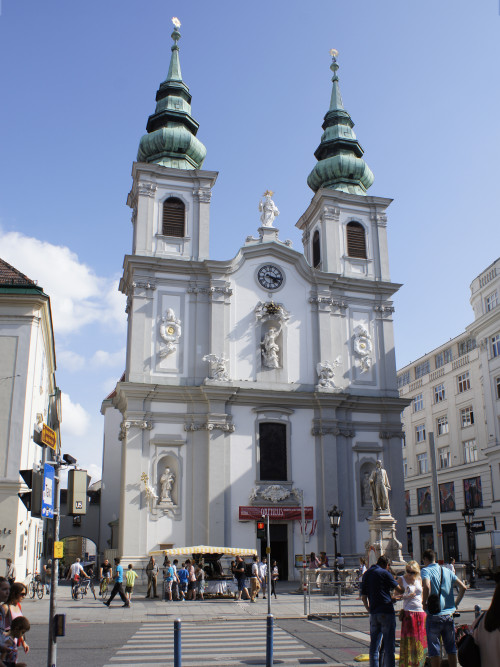
Already in 1660 a modest chapel with the miraculous image "Mariahülf" stood here. This representation of the Virgin Mary is a replica of the picture of grace on Mariahilfer Berg near Passau, which is today on the main altar of the parish church of Innsbruck. History tells us that these images have miraculous powers. At the end of the 17th century, the first church was built here, which was repeatedly extended in the 18th century.
Should we visit a church already now? What's the argument against it? We are not far yet, we will see enough baroque churches. What's the argument for it? The picture of grace. We will encounter it again and again along the way, it will accompany us through Austria. In three or four weeks we will see the original, in Innsbruck, in the parish church dedicated to St. James.
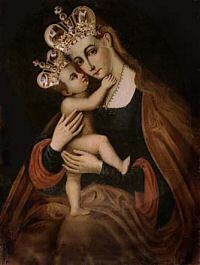
The Mariahilf picture in Vienna, Mariahilf

The original in Innsbruck. It was painted by Lucas Cranach in 1537.
We continue west through the busy shopping street, cross the Gürtel at Westbahnhof station and stay on Mariahilferstrasse for about 1.1 km until the Technical Museum appears on the right and the Auer-Welsbach Park on the left. The authentic (Marien-) pilgrim path leads through Linzerstrasse. But we cross the Auer-Welsbach Park diagonally towards the entrance of Schönbrunn Palace. Finally we are allowed to walk on gravel instead of the endless asphalt.
Carl Freiherr Auer von Welsbach (1858 -1929) was the inventor of the incandescent mantle (gas light), the metal filament lamp made of osmium and flint. He discovered several chemical elements and created the OSRAM trademark.
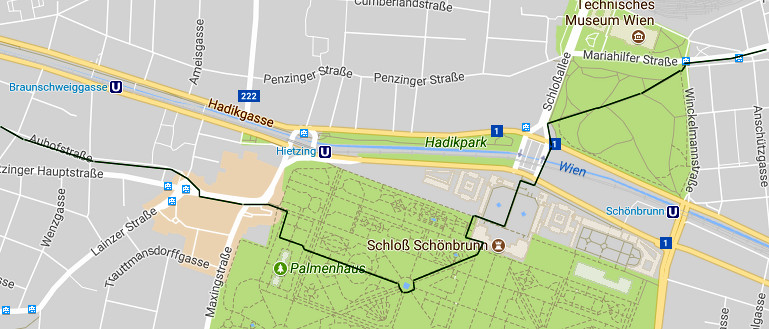
We go to the big courtyard of the castle. As it is not possible to walk through the castle building, we turn right until we are on the other side of the castle in the castle park and walk a few steps back to the large garden parterre until we see the Gloriette.
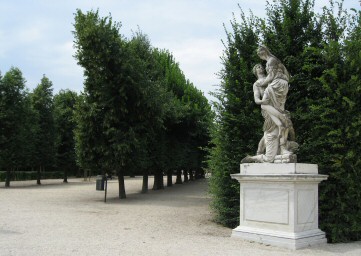
We take the diagonal path (Tiergarten Allee) to the half right. The statue, where we turn off, represents the robbery of Helena (left picture).

It takes a lot of patience for such a photo without tourists.
![]() Click on the fountain and see how it looks like after its restoration in 2018.
Click on the fountain and see how it looks like after its restoration in 2018.
The Diagonalweg (diagonal path) leads to a fountain. It is the fountain with the naiad and the sea monster, from whose throat a fountain of water rises. If we stand behind the fountain and look in the direction of the castle, we see one of the most beautiful photo subjects of Schönbrunn (picture on the right or on the smartphone on top). From the fountain we walk to the rose garden and straight on to the Palm House and look at the Hietzinger Church (picture left below) and from there we walk diagonally left to the Hietzinger Tor.
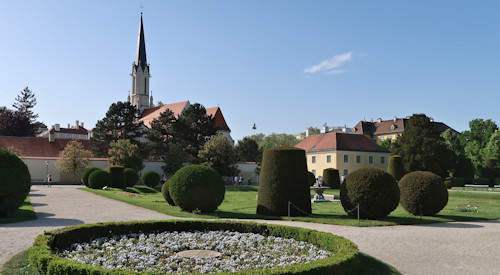
Picture of the Hietzinger parish church. In the foreground the baroque garden in front of the Schönbrunn Palm House.
The flower decoration changes.
see 2011
or 2014
or 2018 April
or 2018 Oktober
or 2021 Oktober
We leave the park of the castle and come to the Hietzinger Platz. The Hietzinger parish church there, which is closely connected to the monastery of Klosterneuburg, houses a statue of the Virgin Mary. The church presents itself inside freshly renovated in neo-Gothic style.
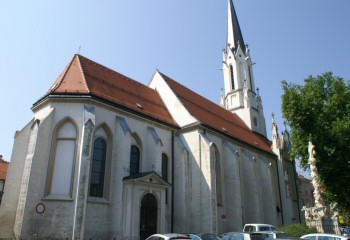
The parish and pilgrimage church Maria Hietzing.
What looks like an entrance door to the choir is the outer chapel for Johannes Nepomuk.
To the right of the church is a Marian column and even further to the right (small picture click below) the monument of Maximilian, the Emperor of Mexico, the younger brother of Emperor Franz Josef of the House of Habsburg.


Already in 1253 there was a chapel of the Virgin Mary here. It was destroyed and rebuilt several times. In 1529, at the time of the first Turkish siege, the statue was removed from the chapel and hidden in a densely leafy tree. The Turks put four Hietzinger citizens in chains and tied them to the tree. In their distress the men called Maria to help and in the night the statue began to glow and the chains fell off.

Click on Maria Hietzing for a larger picture and on the small picture of the altar for a larger overall picture with the legend.
The trail continues along Hietzinger Hauptstrasse for a while until we pass Café Dommayer and turn into Auhofstrasse. We stay on Auhofstrasse and walk almost always under avenue trees. We walk through Unter St. Veit, come to Ober St. Veit and cross the Firmiangasse, named after Bishop Firmian. If you look left into Firmiangasse, you will see St. Nepomuk of Ober St. Veit (if the cars parked there allow it). Learn more about Ober St. Veit, his Nepomuk and about the largely unknown Castle of Ober St. Veit.
Auhofstrasse
Our way to Santiago leads further through the Auhofstrasse. At Auhofstrasse 169 we pass the modern building of the Oblate Monastery. Soon after, the entrance to the Dominican convent of Ober St. Veit is also on the left. Then we pass Joseph's hospital and turn right into Gustav Seidel Gasse and after a few meters left again into the so-called "Promenade", a pedestrian path parallel to the west entrance (red-white-red markings). Protected by a noise barrier, we walk further out of town under trees until the "Promenade" meets Auhofstrasse again and turns into Hofjagdstrasse.
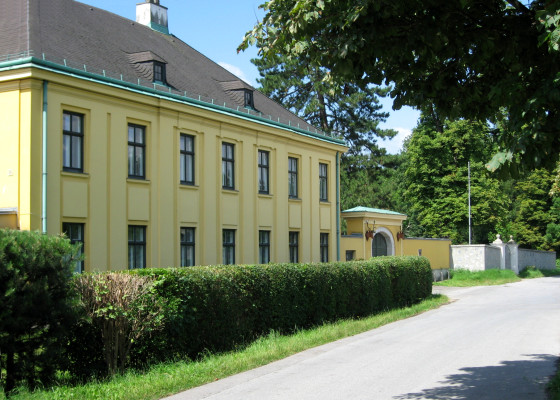
Now we walk along the pedestrian walkway/cycle path - a bit unprotected from the noise - next to the west entrance along the Tiergarten wall past the transformer station west to the Auhof (see picture).
There is a pedestrian bridge over the motorway feeder road on the right, the Auhofbrücke. It leads us to the 'Wolf in der Au Brücke' across the Wien river. After the bridge and the following short straight stretch of road - avenue without traffic - we can turn left and walk down to the Wienfluss. It is the Wienfluss cycle path, which we now follow further west. (This path is closed during high water and in winter, then there is only a detour to Linzerstrasse / Hauptstrasse until Maria Brunn).
We come to the bridge over the Mauerbach, cross it and continue straight ahead along the Wien River.
For cyclists there is a rail for pushing on this bridge.

We can already see the former monastery Maria Brunn and walk past it until a small path leads down to the right (to Pfarrgasse).
This way we reach the pilgrimage church Maria Brunn. In the adjacent parsonage there is a pilgrim's stamp and the nice parish secretary also unlocked the gate in the church for us, so that we could go right to the high altar with the statue of Mary.
The statue of the Virgin Mary (lime wood, late Gothic/early Renaissance) from the 1st half of the 16th century
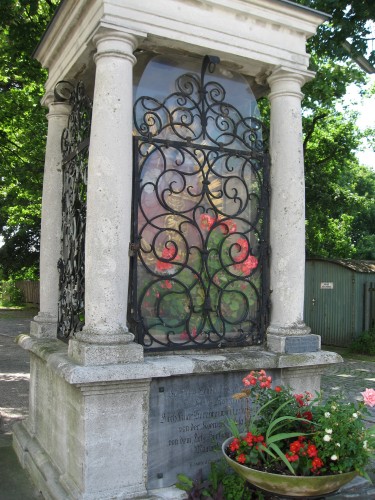
Next to the church there is a fountain (in the picture to the right of the church).
In the fountain structure there is a replica of the statue of the Virgin Mary made of sandstone.

The legend tells: In 1042, Queen Gisela, widow of St. Stephen of Hungary, walked here in the flat meadows of the Vienna River. She was ill and wanted to find rest. Gisela became thirsty. Her servants drew from a well and saw a statue of the Virgin Mary in it. When Gisela drank from this water, she immediately recovered. She had the statue lifted out of the well and had a small chapel built, but soon it was destroyed by the Vienna River. So the statue was moved to the former parish church Weidlingau.
In 1467, when Matthias Corvinius' soldiers were in the area, they accidentally (for no apparent reason) threw the statue into the same well. Thereupon the statue was forgotten. After many years music resounded from the well. It was thought that angels were making music here, remembered the statue and pulled it out of the well for the second time.
Under Emperor Ferdinand II a monastery for the Order of the barefoot Augustinians was built here (mid-17th century) in place of a 16th century chapel. The monastery was dissolved in 1828. The Imperial Forestry Academy (Josef Ressel studied here) was added to the monastery building. Since 1875 the monastery building in Mariabrunn has been home to part of the Federal Research and Training Centre for Forests, Natural Hazards and Landscape. From Mariabrunn we walk the short distance back to the path next to the Wien River, from which we came, and continue westwards to the end of the path.
We cross two roads. The path turns right and joins the main road. After a few meters, opposite a bus station, we can read the history of Weidlingau on a sign. We cross the main road and turn right into Herzmanskystrasse.
The street was named after August Herzmansky (1834 -1896). He is known to us as the founder of the (former) department store Herzmansky in Mariahilferstrasse. Here in Weidlingau he donated a convalescent home for children.
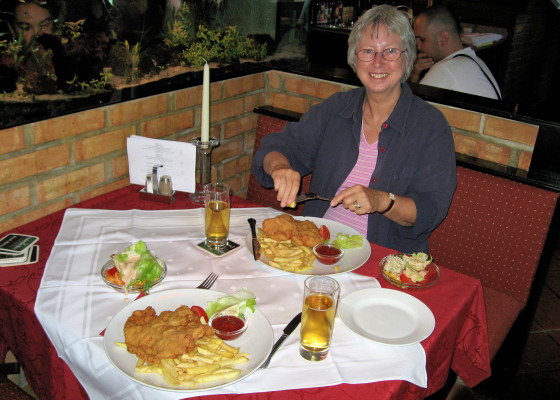
At the corner is the Pizzeria Bardolino. There we had a cheap and rich meal.
The Herzmanskystrasse leads us to the train station Wien-Weidlingau, which we pass. From now on we stay always between the Wien river on the left and the train on the right. This is followed by a thoroughly romantic stretch of the Christkindlweg through the "Christkindlwald". Unimaginable the poor pilgrims reading the Outdoor Guide and walking on the other side of the Wien river (and the noise barrier) along the busy Wientalstrasse, not knowing how beautiful and quiet it is here. Only the Wien river is rushing. The border between Vienna and Lower Austria runs exactly in the middle of the path.
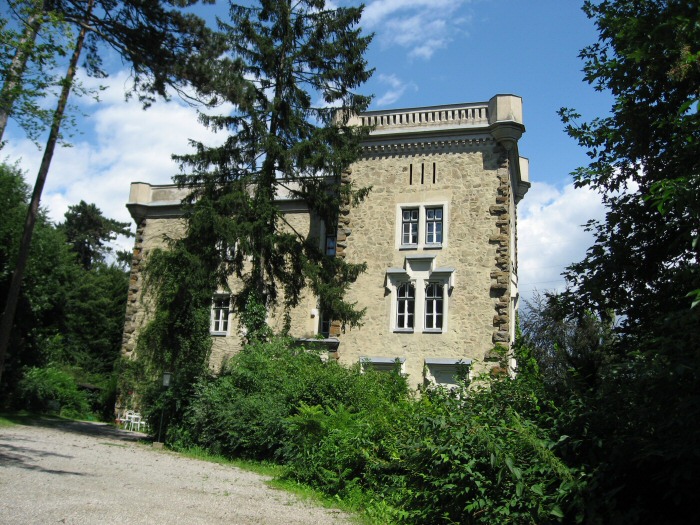
There are also no houses along the way with one exception.
The Christkindlweg leads from the station "Purkersdorf-Sanatorium" into Wienzeile, which in turn leads into Bahnhofstrasse, bringing us to the station Unter-Purkersdorf. The Purkersdorf Sanatorium is not located on the Jakobsweg, but on the other side of the Wien river and is an art nouveau building by Josef Hoffmann.
We continue walking along the Purkersdorfer Bahnhofstrasse and see many interesting art nouveau villas and pass, among other things, the Nepalese consulate. We cross the busy Wienerstrasse, which runs underneath us. On the other side of the street is the town hall, and the steeple of Purkersdorf's parish church becomes visible. We walk to the railway underpass, which with "Hauptplatz / Stadtsaal" shows us the way to the main square. Now it is not far to the parish church of Purkersdorf (originally gothic, baroque). It is consecrated to St. James. In it there is the miraculous image "Mary, the Comforter of the Afflicted" and on a table after the entrance we find the pilgrim's stamp.
Did you know that Purkersdorf was originally called Purchhartsdorf? At least that is what it says in a document by Heinrich Jasomirgott (deed of foundation for the Schottenkloster in Vienna, 1158). There a witness Alberonis de Purchhartsdorf is listed.
Purkersdorf, Juli 2008

Our picture of grace "Mary, Comforter of the Afflicted"
In 1709 the owner of the Stieglmühle in Purkersdorf, Helene Wöhrl, attached the miraculous image of rarity to a pasture in order to worship it. Since her daughter Anna Maria was spared during the plague epidemic of 1713, while the village lost almost half of its then approximately 250 inhabitants, the veneration of the picture grew mightily; the call soon spread to Vienna. In 1718/19 a new chapel was built for the picture of grace, but it was closed again by the bishop of Passau, as it had been built without church permission. In 1721/22 the parish received permission for public veneration and the construction of a new chapel became necessary.
Because of the many pilgrims, on 5 May 1727 the picture of the Virgin Mary was transferred to the parish church by Konsistorialrat (member of the advisory board of a bishop) Johann Jakob Cechotti without any ceremonies or pomp.
Since this time Purkersdorf attained the reputation of a place of pilgrimage and was called "Maria Purkersdorf" for a long time. Empress Maria Theresa also often and gladly visited the place of grace and probably donated the silver frame for the "Stillende Madonna" (Nursing Madonna).
Text found on a plaque at the entrance to the church of St. James (shortened, G.E.)
It took us 18.5 km (5.3 miles) from St. Stephen's Cathedral to here. That's enough for now. I'd rather start slowly and stay here for a while. The next overnight accommodation in Ried am Riederberg is about 12 km (7.5 miles) away.
Remarks for cyclists: With a few exceptions, the trail is suitable for cycling. You are not allowed to cycle through the Schönbrunn Palace Park, so I recommend to use the cycle path in Schönbrunn Palace Avenue to Kennedy Bridge and then go straight on via Kleingasse, Domayergasse into Aufhofstrasse. At the level of the Lilienberggassee, one gets over a downhill ramp to the Wientalradweg at the bottom of the Wien river, which the hikers come across later. Those who prefer to ride "above ground" follow the path described above; the stairs of the Auhofbrücke bridge are equipped with wheel slide rails.
Considerations about the path: The lower Mariahilferstrasse is a pedestrian-friendly zone with trees. The upper Mariahilferstrasse (1.1km), even with trees, is not quite as pedestrian friendly, but still gold compared to the Linke Wienzeile recommended in the guides. Walking through the park of Schönbrunn Palace is certainly not an authentic pilgrimage route, but a beautiful one. Auhofstrasse is a shady avenue with little traffic and interesting villas (Gustav Klimt Villa: Feldmühlgasse 11 - but is a detour). In Hofjagdstrasse you also walk under trees, somewhat separated from traffic. The hike along the Vienna River via Mariabrunn is very beautiful.

